A motor glider is a fixed-wing aircraft that can be flown with or without engine power. The FAI Gliding Commission Sporting Code definition is: a fixed-wing aerodyne equipped with a means of propulsion (MoP), capable of sustained soaring flight without thrust from the means of propulsion.

Van's Aircraft, Inc. is an American kit aircraft manufacturer founded by Richard VanGrunsven in 1973. The Van's RV series aircraft are all-aluminum, low-wing monoplanes of monocoque construction. In 2023, over 11,000 Van's aircraft were flying worldwide, one third of the USA's experimental aircraft fleet.

The Van's RV-4 is an American light homebuilt aircraft supplied in kit form by Van's Aircraft of Aurora, Oregon. It seats two people in a tandem seating configuration with the pilot accommodated in the front seat.

The Schempp-Hirth Nimbus-4 is a family of high-performance FAI Open Class gliders designed by Klaus Holighaus and manufactured by Schempp-Hirth Flugzeugbau GmbH in Kirchheim, Germany. The Nimbus-4 first flew in 1990.
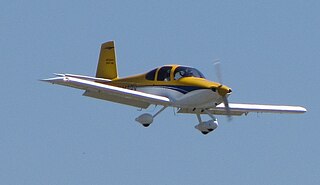
The Van's Aircraft RV-10 is a four-seat, single-engine, low-wing homebuilt airplane sold in kit form by Van's Aircraft. It is the first four-seat airplane in the popular RV series. The RV-10 first flew on 29 May 2003, and the first kit parts were delivered to a customer in September 2003.
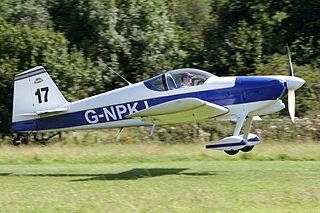
The Van's RV-6 and RV-6A are two-seat, single-engine, low-wing homebuilt airplanes sold in kit form by Van's Aircraft. The RV-6 is the tail-wheel equipped version while the RV-6A features a nose-wheel. The RV-6 was the first aircraft in the popular Van's RV series to feature side-by-side seating and the first to offer a nosewheel option. It was first flown in 1985. Over 2700 kits have been completed and flown.

The Van's RV-9 and RV-9A are American two-seat, single-engine, low-wing homebuilt airplanes sold in kit form by Van's Aircraft of Aurora, Oregon. The RV-9 is the tail-wheel equipped version while the RV-9A features a nose-wheel.
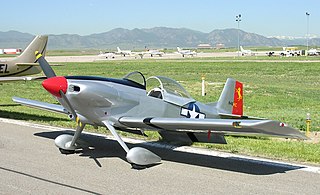
The Van's RV-3 is a single-seat, single-engine, low-wing kit aircraft sold by Van's Aircraft. Unlike many other aircraft in the RV line, the RV-3 is only available as a tail-wheel equipped aircraft, although it is possible that some may have been completed by builders as nose-wheel versions. The RV-3 is the genesis design for the rest of the RV series, all which strongly resemble the RV-3. The RV-4 was originally developed as a two-seat RV-3.

The Van's RV-12 is an American two-seat, single-engine, low-wing homebuilt airplane eligible for the U.S. E-LSA category, sold in kit form and as a complete ready-to-fly aircraft by Van's Aircraft of Aurora, Oregon.

The Grob G109 is a light aircraft developed by Grob Aircraft AG of Mindelheim Mattsies in Germany. It first flew in 1980. The G109B followed in 1984. It is a two-seat self-launching motor glider in which the pilot and passenger or student sit side by side, with good visibility provided by large windows.
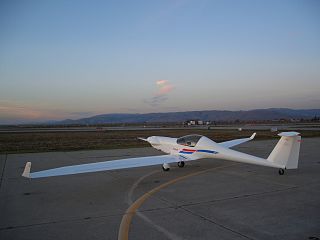
The AMS-Flight Carat A is a single-seat, high performance motorglider. The sailplane was originally designed and built by Technoflug in Germany and is now manufactured by AMS-Flight in Slovenia.
AMS Flight is a manufacturer of gliders, motorgliders and ultralight aircraft. It is based in Begunje na Gorenjskem, Slovenia.

The Scheibe Bergfalke is a German glider designed by Egon Scheibe as a post-World War II development of the Akaflieg München Mü13 produced before and during the war.

The Stits SA-3A Playboy is a single seat, strut-braced low-wing monoplane that was designed by Ray Stits for amateur construction. The aircraft was designed and the prototype was completed in a three-month period during 1952. The design went on to become one of the most influential in the post-war boom in aircraft homebuilding.

The Aviastroitel AC-5M is a Russian mid-wing, single-seat, T-tailed motor glider and unmanned aerial vehicle that is produced by Aviastroitel, now Glider Air Craft.

The RV-1 is a Stits Playboy that was constructed with modifications by Richard VanGrunsven. The aircraft was the first of a series of Van's aircraft that became the most popular homebuilt aircraft produced.

The Van's Aircraft RV-14 is an American aerobatic kit aircraft designed by Richard VanGrunsven and produced by Van's Aircraft. It was introduced at AirVenture in July 2012. The aircraft is supplied as a kit for amateur construction.
The Aerola Alatus is a Ukrainian mid-wing, single-seat, glider and motor glider, designed and produced by Aerola of Kyiv.
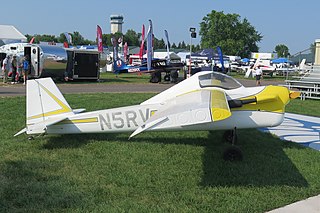
RV-5 is a one-off proof-of-concept prototype airplane designed by Richard VanGrunsven. Although the designation is the 5th in the Van's Aircraft "RV" series, the RV-5 was never intended as a production aircraft but as a project for VanGrunsven and fellow members of his Experimental Aircraft Association (EAA) chapter.

RV-2 is Richard VanGrunsven’s designation for a proposed single-seat tailless glider with all-wood structure and a 40-foot wingspan. The airplane has same configuration as the Backstrom EPB-1C and Marske XM-1D, although with a swept vertical stabilizer similar to that of the Marske Pioneer.


















